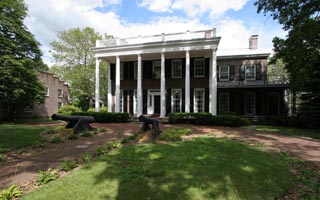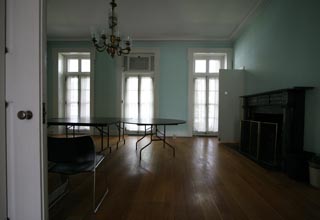On December 7, 1988, Soviet General Secretary Mikhail Gorbachev came to New York City to address the United Nations General Assembly. Following a recitation of the recent changes in the Soviet Union or “perestroika,” Gorbachev amazed the global community when he announced drastic cuts in the Soviet military presence in Eastern Europe, ultimately allowing Soviet satellites to choose their own paths.
Not quite a year later, in November 1989, as a result of perestroika in the Soviet Union and a diminishing presence in Eastern Europe, the most graphic symbol of the Cold War, the Berlin Wall, came down.
In his 1998 book about foreign policy, former President George Bush recalled an important meeting at Governors Island with the leader of the Soviet Union after that historic speech: “As the ferry carrying Mikhail Gorbachev slowly approached the Coast Guard station at Governors Island through the gray waters of New York harbor, a feeling of tense expectation spread across the waiting knots of US and Soviet officials. The arrival field had been largely cleared of spectators and Coast Guardsmen and their families peered rom windows, eagerly waiting to glimpse the Soviet leader as he stepped out onto the island. It was a crisp December 7, 1988, and I was looking toward seeing Gorbachev, who had just finished a major address to the United Nations General Assembly–one filled with farreaching arms control proposals. He was on his way to meet with President Ronald Reagan for a brief summit, which had been tacked on to the tail end of his visit to New York.”
Bush recalled: “His address that day at the UN had been dramatic in both content and delivery, and it was obvious he loved the gamesmanship that went with an appearance there. It was an encouraging
speech. Gorbachev had said that the threat or use of force should no longer be an instrument of foreign policy. He had promised to shift Soviet military doctrine to a more defensive stance and would unilaterally reduce their armed forces by 500,000 in two years–which, given their total size, was small but a good start. He also announced that several armored divisions ould be withdrawn from Czechoslovakia, Hungary, and East Germany by 1991 and disbanded.”
In planning his trip to the United Nations, Gorbachev had requested a meeting with President Ronald Reagan. With Reagan in final weeks of his presidential term, his advisors felt it important that the visit remain low profile, so there would be no large scale summit or state visit to the White House. Yet, a short and informal meeting between the heads of state and newly elected President George Bush was possible. The White House selected the U.S. Coast Guard base at Governors Island as a meeting site since it was a secure military installation in the middle of New York harbor and just minutes away from the United Nations.
Bush continued: “A broadly smiling Gorbachev emerged from the ferry waving, dressed in a smartly tailored gray suit and a serious red tie. With only a month and a half to go in his term, this would be
Reagan’s farewell meeting with a man he had come to respect and for whom he felt genuine fondness and friendship. Reagan had brought the US-Soviet relationship a long way forward. He had dispelled the myth that he opposed absolutely everything to do with the Soviet Union, and the Soviet leaders no longer looked upon him as an unreconstructed Cold Warrior.” Meeting in the 1840-era commanding officer’s residence that now adjoins the Governors Island National Monument, there were moments of tension and humor.
As Bush observed: “…he genuinely flared up when Reagan innocently asked him about progress in reform and perestroika. Gorbachev, with some real feeling, replied, “Have you completed all the reforms you
need to complete?” I think he had misinterpreted the question as a criticism, because after we talked about our desire to see reform succeed he calmed down considerably and his good humor returned.”
Later on President Reagan humorously noted the only thing he was not able to do during his presidency was to bring horses back to the U.S. cavalry. Gorbachev acknowledged Reagan’s love of horses, but shared that he had never had the opportunity to be around them. He told Reagan he could never remember from which side to mount a horse.
With enthusiasm, Reagan responded: “On the left! On the left! Gorbachev, not expecting such passionate uttering of the word “left” by the politically conservative President and retiring Cold Warrior broke
up laughing.
A photo opportunity presented the media covering the event was that of Reagan, Gorbachev and Bush gathered on a platform on the opposite side of the island with the Statue of Liberty in the background. The symbolism outlasted the moment.
The role that Governors Island played in the end of the Cold War had implications for the island. The “Peace Dividend” realized by the end of the Cold War resulted in the closing of base in 1996, ending
its use as a military installation in New York harbor since 1794.
Text from National Park Service website
Pictures of Admiral’s House

The meeting of Gorbachev, Reagan, and Bush took place in the Admiral’s House on Governors Island on 12/7/1988.

The room in the Admiral’s House where the Gorbachev-Reagan meeting took place.